Paper Menu >>
Journal Menu >>
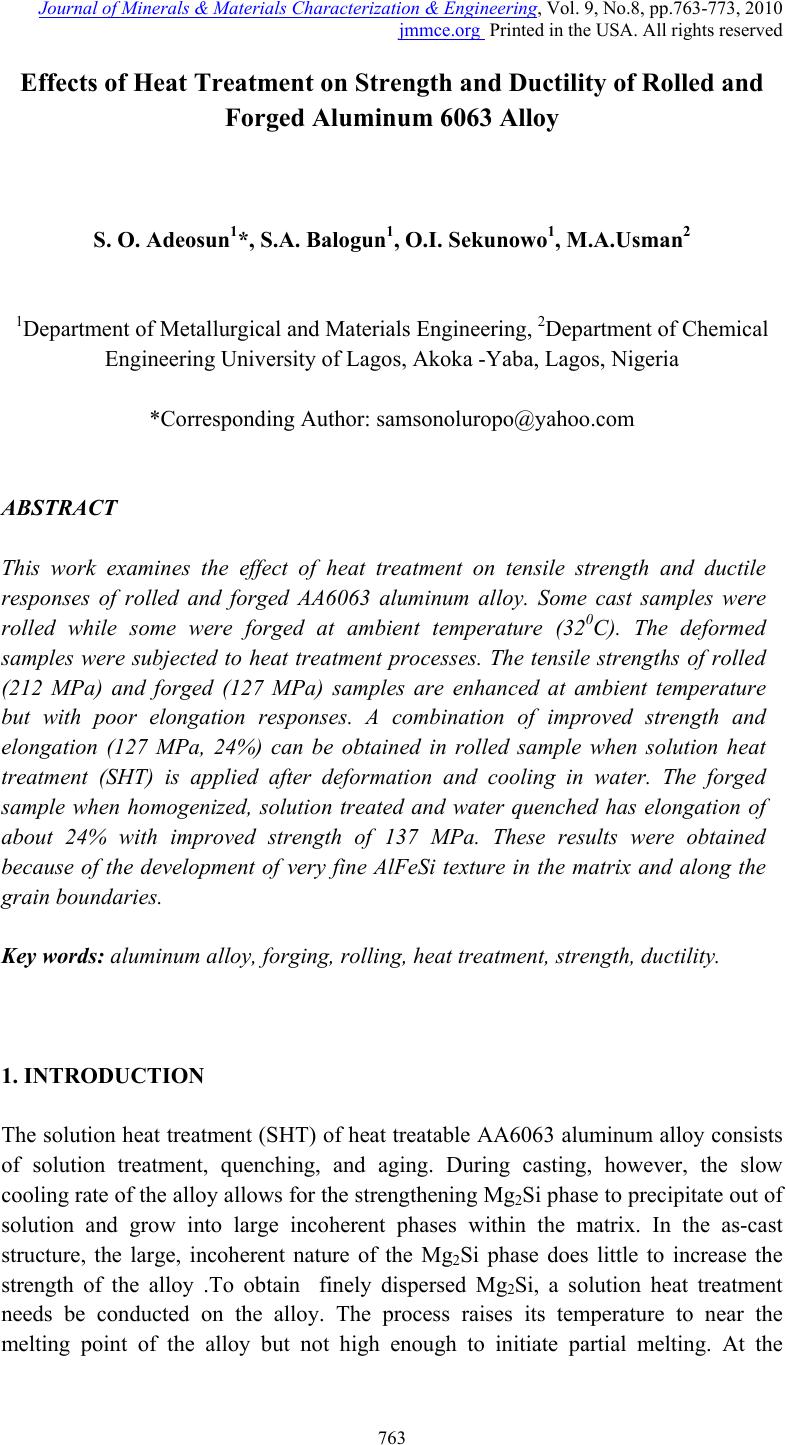 Journal of Minera ls & Materials Ch ar ac te ri zatio n & Engineeri ng, Vol. 9, No.8, pp.763-773, 2010 jmmce.org Printed in the USA. All rights reserved 763 Effects of Heat Treatment on Strength and Ductility of Rolled and Forged Aluminum 6063 Alloy S. O. Adeosun1*, S.A. Balogun1, O.I. Sekunowo1, M.A.Usman2 1Department of Metallurgical and Materials Engineering, 2Department of Chemical Engineering University of Lagos, Akoka -Yaba, Lagos, Nigeria *Corresponding Author: samsonoluropo@yahoo.com ABSTRACT This work examines the effect of heat treatment on tensile strength and ductile responses of rolled and forged AA6063 aluminum alloy. Some cast samples were rolled while some were forged at ambient temperature (320C). The deformed samples were subjected to heat treatment processes. The tensile strengths of rolled (212 MPa) and forged (127 MPa) samples are enhanced at ambient temperature but with poor elongation responses. A combination of improved strength and elongation (127 MPa, 24%) can be obtained in rolled sample when solution heat treatment (SHT) is applied after deformation and cooling in water. The forged sample when homogenized, solution treated and water quenched has elongation of about 24% with improved strength of 137 MPa. These results were obtained because of the development of very fine AlFeSi texture in the matrix and along the grain boundaries. Key words: aluminum alloy, forging, rolling, heat treatment, strength, ductility. 1. INTRODUCTION The solution heat treatment (SHT) of heat treatable AA6063 aluminum alloy consists of solution treatment, quenching, and aging. During casting, however, the slow cooling rate of the alloy allows for the strengthening Mg2Si phase to precipitate out of solution and grow into large incoherent phases within the matrix. In the as-cast structure, the large, incoherent nature of the Mg2Si phase does little to increase the strength of the alloy .To obtain finely dispersed Mg2Si, a solution heat treatment needs be conducted on the alloy. The process raises its temperature to near the melting point of the alloy but not high enough to initiate partial melting. At the 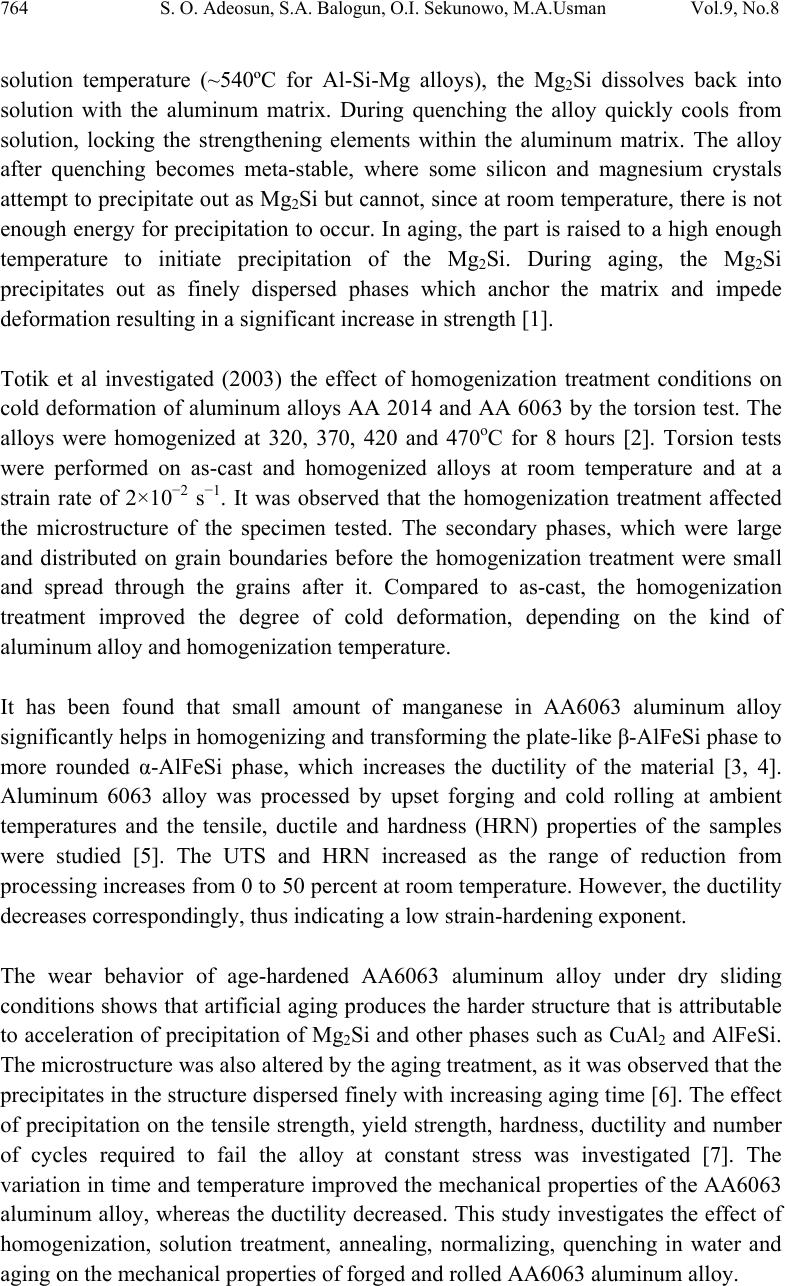 764 S. O. Adeosun, S.A. Balogun, O.I. Sekunowo, M.A.Usman Vol.9, No.8 solution temperature (~540ºC for Al-Si-Mg alloys), the Mg2Si dissolves back into solution with the aluminum matrix. During quenching the alloy quickly cools from solution, locking the strengthening elements within the aluminum matrix. The alloy after quenching becomes meta-stable, where some silicon and magnesium crystals attempt to precipitate out as Mg2Si but cannot, since at room temperature, there is not enough energy for precipitation to occur. In aging, the part is raised to a high enough temperature to initiate precipitation of the Mg2Si. During aging, the Mg2Si precipitates out as finely dispersed phases which anchor the matrix and impede deformation resulting in a significant increase in strength [1]. Totik et al investigated (2003) the effect of homogenization treatment conditions on cold deformation of aluminum alloys AA 2014 and AA 6063 by the torsion test. The alloys were homogenized at 320, 370, 420 and 470oC for 8 hours [2]. Torsion tests were performed on as-cast and homogenized alloys at room temperature and at a strain rate of 2×10−2 s−1. It was observed that the homogenization treatment affected the microstructure of the specimen tested. The secondary phases, which were large and distributed on grain boundaries before the homogenization treatment were small and spread through the grains after it. Compared to as-cast, the homogenization treatment improved the degree of cold deformation, depending on the kind of aluminum alloy and homogenization temperature. It has been found that small amount of manganese in AA6063 aluminum alloy significantly helps in homogenizing and transforming the plate-like β-AlFeSi phase to more rounded α-AlFeSi phase, which increases the ductility of the material [3, 4]. Aluminum 6063 alloy was processed by upset forging and cold rolling at ambient temperatures and the tensile, ductile and hardness (HRN) properties of the samples were studied [5]. The UTS and HRN increased as the range of reduction from processing increases from 0 to 50 percent at room temperature. However, the ductility decreases correspondingly, thus indicating a low strain-hardening exponent. The wear behavior of age-hardened AA6063 aluminum alloy under dry sliding conditions shows that artificial aging produces the harder structure that is attributable to acceleration of precipitation of Mg2Si and other phases such as CuAl2 and AlFeSi. The microstructure was also altered by the aging treatment, as it was observed that the precipitates in the structure dispersed finely with increasing aging time [6]. The effect of precipitation on the tensile strength, yield strength, hardness, ductility and number of cycles required to fail the alloy at constant stress was investigated [7]. The variation in time and temperature improved the mechanical properties of the AA6063 aluminum alloy, whereas the ductility decreased. This study investigates the effect of homogenization, solution treatment, annealing, normalizing, quenching in water and aging on the mechanical properties of forged and rolled AA6063 aluminum alloy. 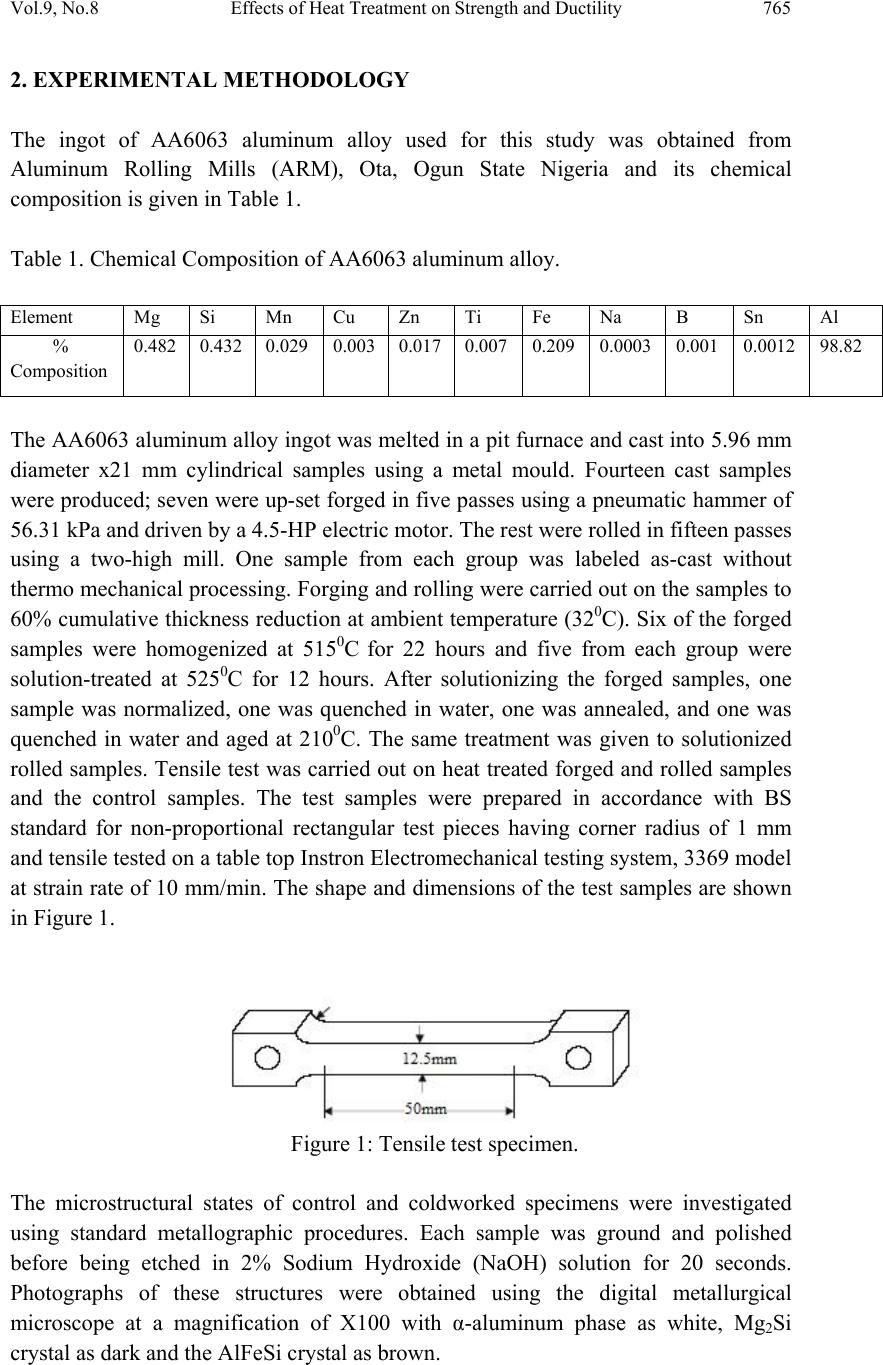 Vol.9, No.8 Effects of Heat Treatment on Strength and Ductility 765 2. EXPERIMENTAL METHODOLOGY The ingot of AA6063 aluminum alloy used for this study was obtained from Aluminum Rolling Mills (ARM), Ota, Ogun State Nigeria and its chemical composition is given in Table 1. Table 1. Chemical Composition of AA6063 aluminum alloy. Element Mg Si Mn Cu Zn Ti Fe Na B Sn Al % Composition 0.482 0.432 0.029 0.003 0.017 0.007 0.209 0.0003 0.001 0.0012 98.82 The AA6063 aluminum alloy ingot was melted in a pit furnace and cast into 5.96 mm diameter x21 mm cylindrical samples using a metal mould. Fourteen cast samples were produced; seven were up-set forged in five passes using a pneumatic hammer of 56.31 kPa and driven by a 4.5-HP electric motor. The rest were rolled in fifteen passes using a two-high mill. One sample from each group was labeled as-cast without thermo mechanical processing. Forging and rolling were carried out on the samples to 60% cumulative thickness reduction at ambient temperature (320C). Six of the forged samples were homogenized at 5150C for 22 hours and five from each group were solution-treated at 5250C for 12 hours. After solutionizing the forged samples, one sample was normalized, one was quenched in water, one was annealed, and one was quenched in water and aged at 2100C. The same treatment was given to solutionized rolled samples. Tensile test was carried out on heat treated forged and rolled samples and the control samples. The test samples were prepared in accordance with BS standard for non-proportional rectangular test pieces having corner radius of 1 mm and tensile tested on a table top Instron Electromechanical testing system, 3369 model at strain rate of 10 mm/min. The shape and dimensions of the test samples are shown in Figure 1. Figure 1: Tensile test specimen. The microstructural states of control and coldworked specimens were investigated using standard metallographic procedures. Each sample was ground and polished before being etched in 2% Sodium Hydroxide (NaOH) solution for 20 seconds. Photographs of these structures were obtained using the digital metallurgical microscope at a magnification of X100 with α-aluminum phase as white, Mg2Si crystal as dark and the AlFeSi crystal as brown.  766 S. O. Adeosun, S.A. Balogun, O.I. Sekunowo, M.A.Usman Vol.9, No.8 3. RESULTS AND DISCUSSION The sample rolled at ambient temperature to a cumulative thickness reduction of 60% has superior UTS (212 MPa) to the forged sample (127 MPa) similarly deformed (see Figures 2-5 and Table 2). Table 2. Ultimate Tensile Strength (UTS) and Elongation Characteristics of processed AA6063 Aluminum alloy. Thermal processing UTS (MPa) Elongation ForgedRolled Forged Rolled Deformed at ambient temperature. 126.98 212.4 2.49 6.1 Deformed and Homogenized. 99.3 104.5 13 14 Deformed and homogenized, SHT and normalized. 73.7 126.7 7.1 19 Deformed, homogenized, SHT and annealed. 102.9 99.7 18 12 Deformed, homogenized, SHT and water quenched 131.8 127.1 25 24 Deformed, homogenized, SHT,water quenched and aged 107.76 93.8 17.2 9.8 As-cast 114.8 114.8 10.6 10.6 However, both samples show poor elongation responses as the values are far less (6.1% and 2.5% respectively) than that obtained in the as-cast sample (10.6%). In the as-rolled sample, the Mg2Si crystals are found at grain boundaries, matrix surface and in the rolling direction, with fine distribution, which serves as obstacles to the motion of dislocation during plastic deformation. 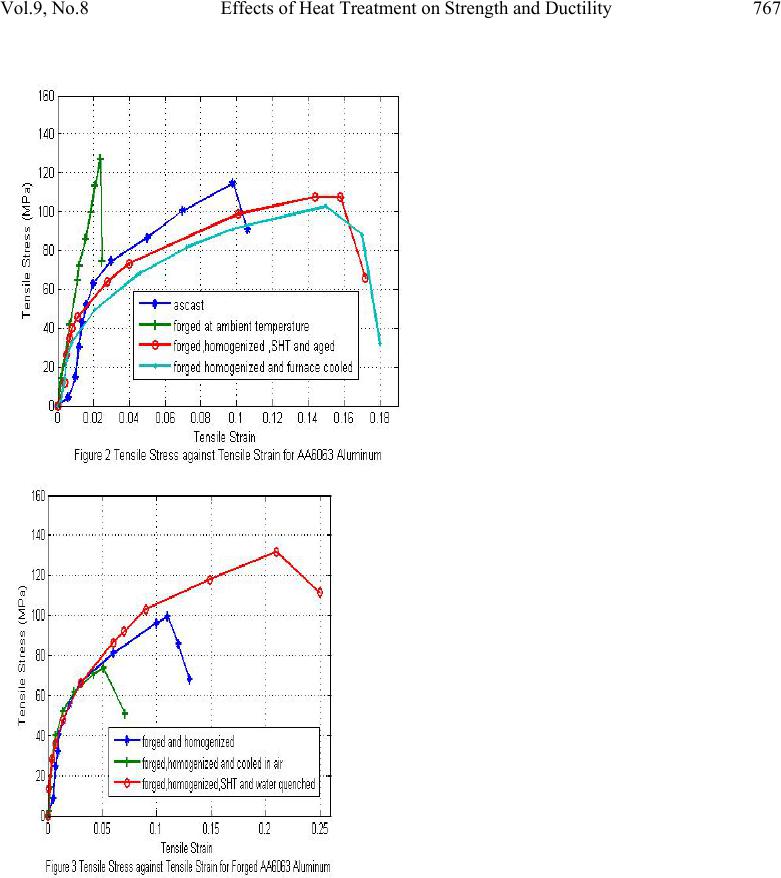 Vol.9, No.8 Effects of Heat Treatment on Strength and Ductility 767  768 S. O. Adeosun, S.A. Balogun, O.I. Sekunowo, M.A.Usman Vol.9, No.8 Other intermetallic crystals are fine and of smaller volume fraction (see Plate 2a). These features promote strength while sacrificing ductility. In the as-forged sample, Mg2Si crystals which are predominantly needle-like in shape are scattered over the matrix surface. The volume of the AlFeSi phase precipitated exceeds that of Mg2Si that has some of its crystals diffused into the matrix consequent upon the applied forging load (see Plate 1a). Homogenizing the forged sample at 515oC and even normalizing after treatment at 525oC does not promote the precipitation of strength enhancing phase over that observed in the as-cast structure. The percent elongation at these heat treatment procedures however, increases significantly over the as-cast. There is a decline in strength of forged sample whereas the property improved in the rolled sample. The volume of Mg2Si and other intermetallics precipitated decreased with Mg2Si crystal distribution in similar pattern to solution treated sample (see Plate 1b). During normalization of homogenized rolled sample, Mg2Si and other intermetallic crystals are precipitated over the homogenized sample. This gave rise to strength and 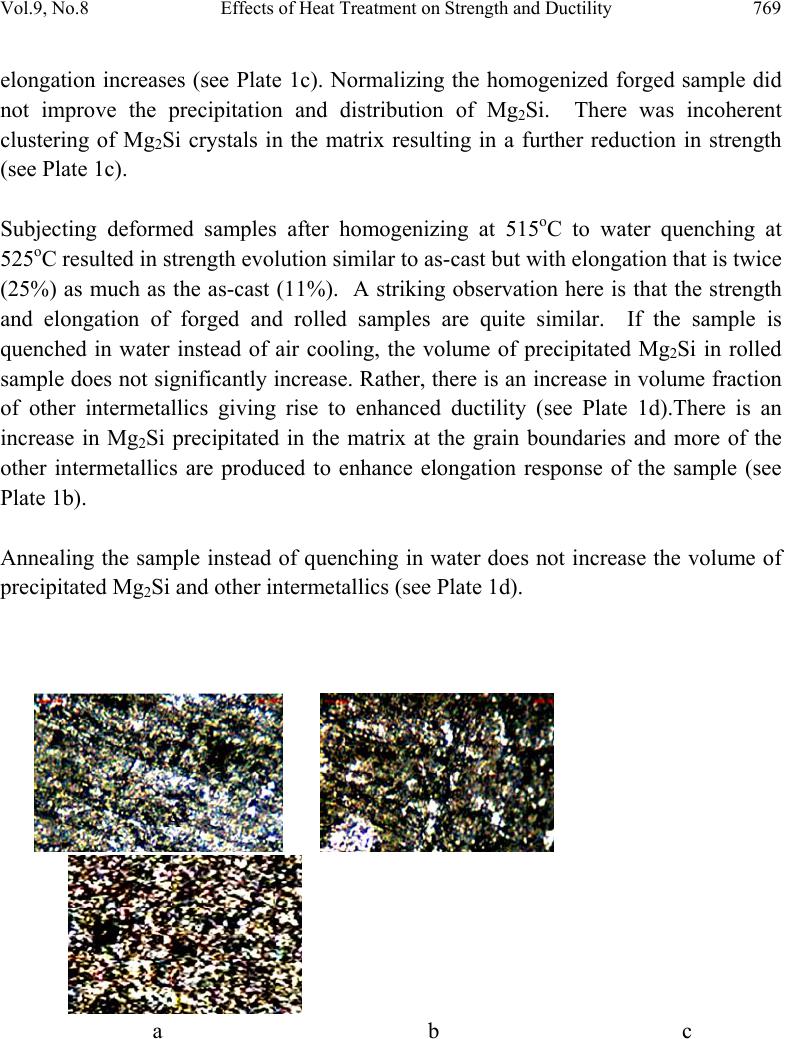 Vol.9, No.8 Effects of Heat Treatment on Strength and Ductility 769 elongation increases (see Plate 1c). Normalizing the homogenized forged sample did not improve the precipitation and distribution of Mg2Si. There was incoherent clustering of Mg2Si crystals in the matrix resulting in a further reduction in strength (see Plate 1c). Subjecting deformed samples after homogenizing at 515oC to water quenching at 525oC resulted in strength evolution similar to as-cast but with elongation that is twice (25%) as much as the as-cast (11%). A striking observation here is that the strength and elongation of forged and rolled samples are quite similar. If the sample is quenched in water instead of air cooling, the volume of precipitated Mg2Si in rolled sample does not significantly increase. Rather, there is an increase in volume fraction of other intermetallics giving rise to enhanced ductility (see Plate 1d).There is an increase in Mg2Si precipitated in the matrix at the grain boundaries and more of the other intermetallics are produced to enhance elongation response of the sample (see Plate 1b). Annealing the sample instead of quenching in water does not increase the volume of precipitated Mg2Si and other intermetallics (see Plate 1d). a b c A  770 S. O. Adeosun, S.A. Balogun, O.I. Sekunowo, M.A.Usman Vol.9, No.8 d e f g Plate 1. Structural morphology of rolled samples (a) deformed at ambient (b) deformed and homogenized at 5150C (c) deformed, homogenized at 5150C and normalized at 5250C (d) deformed, homogenized at 5150C and water quenched at 5250C (e) deformed, homogenized at 5150C and annealed at 5250C (f) deformed, homogenized at 5150C, quenched and aged at 2100C (g) as-cast.  Vol.9, No.8 Effects of Heat Treatment on Strength and Ductility 771 a b c d e f g Plate 2. Structural morphology of forged samples (a) deformed at ambient (b) deformed and homogenized at 5150C (c) deformed, homogenized at 5150C and normalized at 5250C (d) deformed, homogenized at 5150C and water quenched at 5250C (e) deformed, homogenized at 5150C and annealed at 5250C (f) deformed, homogenized at 5150C, quenched and aged at 2100C ( g) as-cast. Annealing forged sample after homogenization does not produce significant improvement in strength (103 MPa) over the homogenized sample (99MPa). But the elongation improves (18% as against 13%) due to the increased precipitation of other intermetallics (see Plate 2e). Annealing after SHT at 5250C, water quenching and ageing at 2100C and homogenization treatments did not enhance the tensile strength of both forged and rolled samples. However ductility improved. Ageing the quench sample at 2100C does not improve the precipitation of the strengthening phase (see Plate 2f). At 60% cumulative reduction and in the range of heat treatment considered, rolled samples allowed for the evolution of strengthening precipitates, permit increase 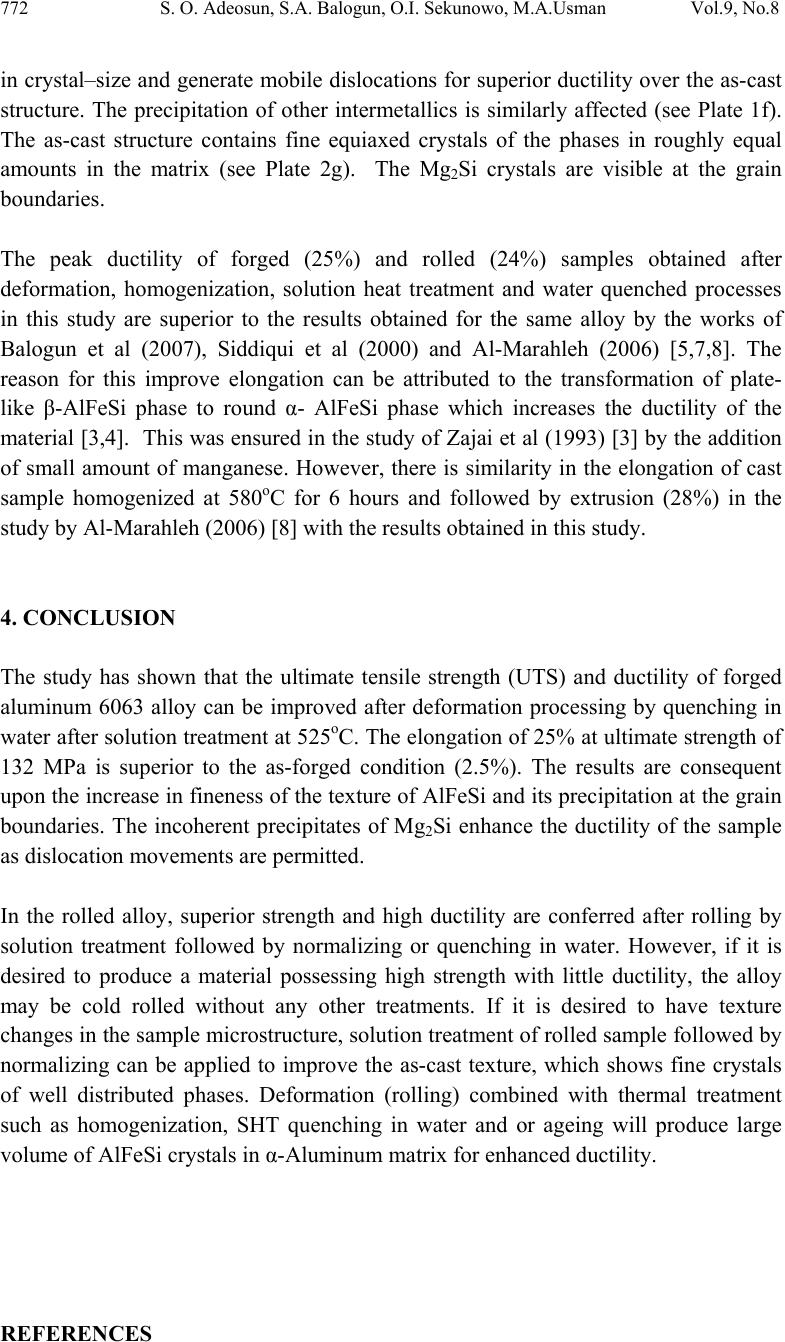 772 S. O. Adeosun, S.A. Balogun, O.I. Sekunowo, M.A.Usman Vol.9, No.8 in crystal–size and generate mobile dislocations for superior ductility over the as-cast structure. The precipitation of other intermetallics is similarly affected (see Plate 1f). The as-cast structure contains fine equiaxed crystals of the phases in roughly equal amounts in the matrix (see Plate 2g). The Mg2Si crystals are visible at the grain boundaries. The peak ductility of forged (25%) and rolled (24%) samples obtained after deformation, homogenization, solution heat treatment and water quenched processes in this study are superior to the results obtained for the same alloy by the works of Balogun et al (2007), Siddiqui et al (2000) and Al-Marahleh (2006) [5,7,8]. The reason for this improve elongation can be attributed to the transformation of plate- like β-AlFeSi phase to round α- AlFeSi phase which increases the ductility of the material [3,4]. This was ensured in the study of Zajai et al (1993) [3] by the addition of small amount of manganese. However, there is similarity in the elongation of cast sample homogenized at 580oC for 6 hours and followed by extrusion (28%) in the study by Al-Marahleh (2006) [8] with the results obtained in this study. 4. CONCLUSION The study has shown that the ultimate tensile strength (UTS) and ductility of forged aluminum 6063 alloy can be improved after deformation processing by quenching in water after solution treatment at 525oC. The elongation of 25% at ultimate strength of 132 MPa is superior to the as-forged condition (2.5%). The results are consequent upon the increase in fineness of the texture of AlFeSi and its precipitation at the grain boundaries. The incoherent precipitates of Mg2Si enhance the ductility of the sample as dislocation movements are permitted. In the rolled alloy, superior strength and high ductility are conferred after rolling by solution treatment followed by normalizing or quenching in water. However, if it is desired to produce a material possessing high strength with little ductility, the alloy may be cold rolled without any other treatments. If it is desired to have texture changes in the sample microstructure, solution treatment of rolled sample followed by normalizing can be applied to improve the as-cast texture, which shows fine crystals of well distributed phases. Deformation (rolling) combined with thermal treatment such as homogenization, SHT quenching in water and or ageing will produce large volume of AlFeSi crystals in α-Aluminum matrix for enhanced ductility. REFERENCES 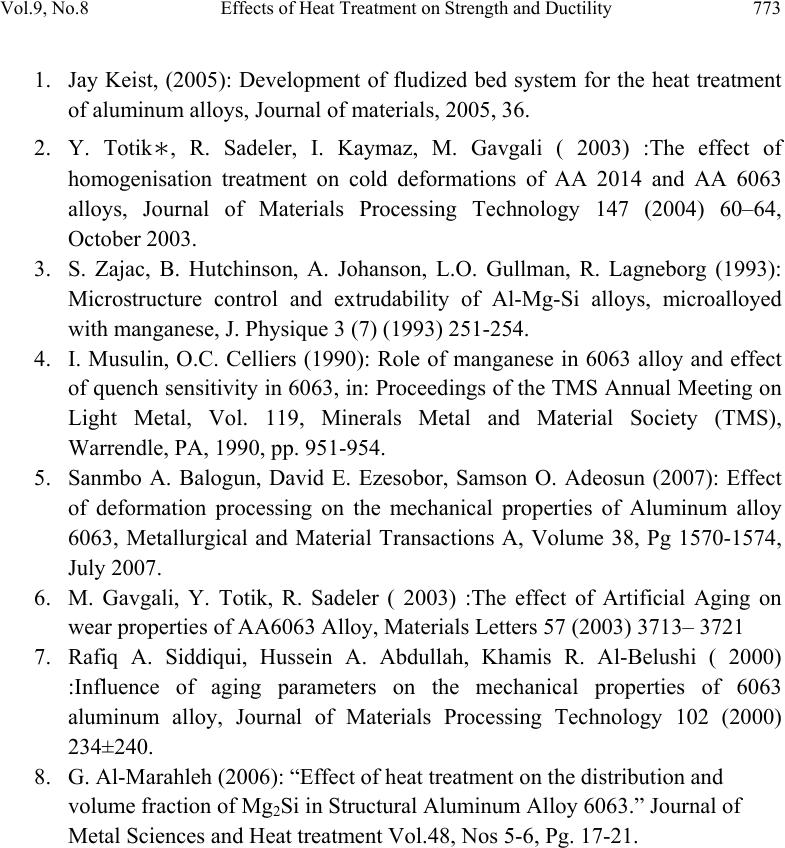 Vol.9, No.8 Effects of Heat Treatment on Strength and Ductility 773 1. Jay Keist, (2005): Development of fludized bed system for the heat treatment of aluminum alloys, Journal of materials, 2005, 36. 2. Y. Totik∗, R. Sadeler, I. Kaymaz, M. Gavgali ( 2003) :The effect of homogenisation treatment on cold deformations of AA 2014 and AA 6063 alloys, Journal of Materials Processing Technology 147 (2004) 60–64, October 2003. 3. S. Zajac, B. Hutchinson, A. Johanson, L.O. Gullman, R. Lagneborg (1993): Microstructure control and extrudability of Al-Mg-Si alloys, microalloyed with manganese, J. Physique 3 (7) (1993) 251-254. 4. I. Musulin, O.C. Celliers (1990): Role of manganese in 6063 alloy and effect of quench sensitivity in 6063, in: Proceedings of the TMS Annual Meeting on Light Metal, Vol. 119, Minerals Metal and Material Society (TMS), Warrendle, PA, 1990, pp. 951-954. 5. Sanmbo A. Balogun, David E. Ezesobor, Samson O. Adeosun (2007): Effect of deformation processing on the mechanical properties of Aluminum alloy 6063, Metallurgical and Material Transactions A, Volume 38, Pg 1570-1574, July 2007. 6. M. Gavgali, Y. Totik, R. Sadeler ( 2003) :The effect of Artificial Aging on wear properties of AA6063 Alloy, Materials Letters 57 (2003) 3713– 3721 7. Rafiq A. Siddiqui, Hussein A. Abdullah, Khamis R. Al-Belushi ( 2000) :Influence of aging parameters on the mechanical properties of 6063 aluminum alloy, Journal of Materials Processing Technology 102 (2000) 234±240. 8. G. Al-Marahleh (2006): “Effect of heat treatment on the distribution and volume fraction of Mg2Si in Structural Aluminum Alloy 6063.” Journal of Metal Sciences and Heat treatment Vol.48, Nos 5-6, Pg. 17-21. |

